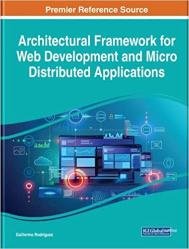Architectural Framework for Web Development and Micro Distributed Applications
- Добавил: literator
- Дата: 30-04-2023, 19:18
- Комментариев: 0
 Название: Architectural Framework for Web Development and Micro Distributed Applications
Название: Architectural Framework for Web Development and Micro Distributed ApplicationsАвтор: Guillermo Rodriguez
Издательство: IGI Global
Год: 2023
Страниц: 292
Язык: английский
Формат: epub (true)
Размер: 12.4 MB
The text introduces the concept of Micro Distributed Applications (MDAs) and their relevance in current software engineering endeavors. In order to understand why the profession has arrived at its current junction and why web development must fundamentally change to encompass the doctrine of distributed jаvascript applications the reader is introduced to the evolutionary factors that have come bear on the profession. These factors have pushed the software engineering domain slowly but surely to the realm of MDAs.
In recent years, we have ushered in a new age where applications will become smaller, distributed, jаvascript-laden, microservices-infused, and utilize the hardware of the client to operate. A new paradigm has been forced upon us by the large search providers, and because of this, we can now leverage them to help our applications obtain influence where our applications become the voice of authority on the internet and consequently help our organizations reap the benefits of mass adoption. To better understand this, we must first consider the history that has taken us to where we find ourselves. Architectural Framework for Web Development and Micro Distributed Applications helps readers to come to an understanding of how the indexing domain may be leveraged by this new wave of jаvascript applications that have been termed micro distributed applications and by whose creation and implementation will allow the enterprise to reap the benefit of influence by the existing search systems that the masses utilize. It helps to fill in the picture of the evolution that has occurred and will continue to occur in web development whereby the new breed of applications will become jаvascript-laden and highly distributed and whereby the businesses that implement them will stand a chance to win the indexing race and consequently stand to win the attention of the masses.
jаvascript is a terse programming language that has provided the ability to take a server side component and transform it to the client side thus putting the burden on the browser to perform the work. Development has progressed from the domain of the thick client where artifacts were installed locally to the anonymous whereby clients interact with the software across the internet. This migration to the client browser has consequently infused browsers to become a window of utility that can be linked to the direct functionality of an application. By doing such it has infused the browser to become a rich and interactive playing field for applications. Applications as a consequence have become more in alignment with what use to be the domain of thick clients. jаvascript as a consequence has created ubiquity in the landscape whereby these lightweight applications can reside anywhere there is a browser and often times without the burden of compliance across browser types given the adherence to the W3C standard. Add to this landscape the plethora of opensource projects that have helped to create functionality for jаvascript, and it has simply functioned to create a tidal wave of innovation and product offerings.
The natural language toolkit (NLTK) is an open source driven project that is available for the Python programming language. The NLTK allows for the creation of solutions that are language centric; the search space has language as a central tenant, which makes the NLTK an ideal utility. Taking the query terms and being able to stem the words provided to their alternatives is paramount in the search space as individuals express themselves differently. A search system must be able to accommodate this difference in its paradigm to be able to accommodate the masses without exclusion. With the NLTK it becomes possible to obtain the stem of the query terms. Through the use of the NLTK it becomes possible to take some query term and map the query term to its alternate representation, thus allowing for the creation of an alternate mapping between some input and a physical artifact that may or may not contain the exact term provided as input but may contain an alternate representation of the query term.
This chapter mirrors a previous chapter where a physical implementation of a micro-distributed application was created. The content of this chapter differs from previous work in that what is developed here is more complex because the housing of the MDA is a WordPress application. What the solution presented here will show however is that by leveraging technology in its prescribed mode it becomes feasible to maintain system homeostasis. This system state may be maintained because MDAs function ubiquitously across housing types due to their architectural framework. What this degree of flexibility exemplifies is that an application can be made to function harmoniously across landscape types because of the degree of resilience that the technology affords. This malleability of Micro-Distributed Applications helps to justify why a transition to distributed jаvascript applications needs to occur as it is a step towards resilience and simplicity.
Covering topics such as distributed systems, search engine optimization, and software as a service, this premier reference source is a dynamic resource for web developers, students and educators of higher education, software developers, technical personnel, IT managers, computer scientists, librarians, researchers, and academicians.
Скачать Architectural Framework for Web Development and Micro Distributed Applications
[related-news] [/related-news]
Внимание
Уважаемый посетитель, Вы зашли на сайт как незарегистрированный пользователь.
Мы рекомендуем Вам зарегистрироваться либо войти на сайт под своим именем.
Уважаемый посетитель, Вы зашли на сайт как незарегистрированный пользователь.
Мы рекомендуем Вам зарегистрироваться либо войти на сайт под своим именем.
